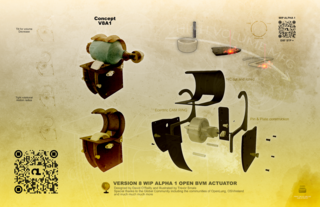
In academic publishing, a preprint is a version of a scholarly or scientific paper that precedes formal peer review and publication in a peer-reviewed scholarly or scientific journal. The preprint may be available, often as a non-typeset version available free, before or after a paper is published in a journal.
Open peer review is the various possible modifications of the traditional scholarly peer review process. The three most common modifications to which the term is applied are:
- Open identities: Authors and reviewers are aware of each other's identity.
- Open reports: Review reports are published alongside the relevant article.
- Open participation: The wider community are able to contribute to the review process.
PLOS Currents was a publishing platform run by the Public Library of Science from 2009 to 2018 as an experiment.
In scientific publishing, the 1969 Ingelfinger rule originally stipulated that The New England Journal of Medicine (NEJM) would not publish findings that had been published elsewhere, in other media or in other journals. The rule was subsequently adopted by several other scientific journals, and has shaped scientific publishing ever since. Historically it has also helped to ensure that the journal's content is fresh and does not duplicate content previously reported elsewhere, and seeks to protect the scientific embargo system.

bioRxiv is an open access preprint repository for the biological sciences co-founded by John Inglis and Richard Sever in November 2013. It is hosted by the Cold Spring Harbor Laboratory (CSHL).
Climate Feedback (CF) is a web-based content annotation tool that allows qualified scientists to comment on stories online, adding context and noting inaccuracies. It is one of three websites under the Science Feedback parent organization that fact-checks media coverage. Science Feedback is a non-profit organization registered in France.
Janice Chen is co-founder and chief technology officer of Mammoth Biosciences, a Brisbane, California-based company founded in 2018 that is developing diagnostic tests using CRISPR. She received her B.S. degree from Johns Hopkins University and as a graduate student at the University of California, Berkeley, she worked in the lab of CRISPR pioneer Jennifer Doudna, receiving her PhD in Molecular and Cell Biology.
medRxiv is an Internet site distributing unpublished eprints about health sciences. It distributes complete but unpublished manuscripts in the areas of medicine, clinical research, and related health sciences without charge to the reader. Such manuscripts have yet to undergo peer review and the site notes that preliminary status and that the manuscripts should not be considered for clinical application, nor relied upon for news reporting as established information.

False information, including intentional disinformation and conspiracy theories, about the scale of the COVID-19 pandemic and the origin, prevention, diagnosis, and treatment of the disease has been spread through social media, text messaging, and mass media. False information has been propagated by celebrities, politicians, and other prominent public figures. Many countries have passed laws against "fake news", and thousands of people have been arrested for spreading COVID-19 misinformation. The spread of COVID-19 misinformation by governments has also been significant.

Media coverage of the COVID-19 pandemic has varied by country, time period and media outlet. News media has simultaneously kept viewers informed about current events related to the pandemic, and contributed to misinformation or fake news.

An open-source ventilator is a disaster-situation ventilator made using a freely licensed (open-source) design, and ideally, freely available components and parts. Designs, components, and parts may be anywhere from completely reverse-engineered or completely new creations, components may be adaptations of various inexpensive existing products, and special hard-to-find and/or expensive parts may be 3D-printed instead of purchased. As of early 2020, the levels of documentation and testing of open-source ventilators was well below scientific and medical-grade standards.

Marcel Salathé is a Swiss digital epidemiologist. He is currently an associate professor at École Polytechnique Fédérale de Lausanne (EPFL) He is the director of the Lab of Digital Epidemiology, based at EPFL's Geneva Campus. In the first year of the COVID-19 pandemic, Salathé was the most quoted scientist in the Swiss media.

The Randomised Evaluation of COVID-19 Therapy is a large-enrollment clinical trial of possible treatments for people in the United Kingdom admitted to hospital with severe COVID-19 infection. The trial was later expanded to Indonesia, Nepal and Vietnam. The trial has tested ten interventions on adults: eight repurposed drugs, one newly developed drug and convalescent plasma.

Li-Meng Yan or Yan Limeng is a Chinese virologist, known for her publications and interviews alleging that SARS-CoV-2 was made in a Chinese government laboratory. Her publications have been widely dismissed as flawed by the scientific community.
COVID-19 datasets are public databases for sharing case data and medical information related to the COVID-19 pandemic.

The COVID-19 lab leak theory, or lab leak hypothesis, is the idea that SARS-CoV-2, the virus that caused the COVID-19 pandemic, is the result of a laboratory leak. The theory is highly controversial; most scientists believe the virus spilled into human populations through natural zoonosis, similar to the SARS-CoV-1 and MERS-CoV outbreaks, and consistent with other pandemics in human history. Available evidence suggests that the SARS-CoV-2 virus was originally harbored by bats, and spread to humans multiple times from infected wild animals at the Huanan Seafood Market in Wuhan, Hubei, China, in December 2019. There is no evidence SARS-CoV-2 existed in any laboratory prior to the pandemic. An original animal reservoir has not yet been confirmed, though several candidate species have been identified.

Kaitlyn Noelle Sadtler is an American immunologist and bioengineer and Stadtman Tenure-Track Investigator at the National Institute of Biomedical Imaging and Bioengineering, known for completing the first population-wide serosurvey during the COVID-19 pandemic in the United States in 2020.
The Local is a Toronto-based general interest online magazine covering urban health and social issues. It was founded in 2019 as a not-for-profit organization, with Tai Huynh, Nicholas Hune-Brown, Jen Recknagel and Craig Madho as its founding editorial team. The Local publishes mostly long-form features, investigations and essays on a quarterly basis. From 2017 to 2019, The Local was a hyper-local storytelling project incubated at UHN OpenLab, a design and innovation studio at the University Health Network.

Lambda variant, also known as lineage C.37, is a variant of SARS-CoV-2, the virus that causes COVID-19. It was first detected in Peru in August 2020. On 14 June 2021, the World Health Organization (WHO) named it Lambda variant and designated it as a variant of interest. It has spread to at least 30 countries around the world and is known to be more resistant to neutralizing antibodies compared to other strains. There is evidence that suggests the Lambda variant is both more infectious and resistant to vaccines than the Alpha and/or Gamma variant.








